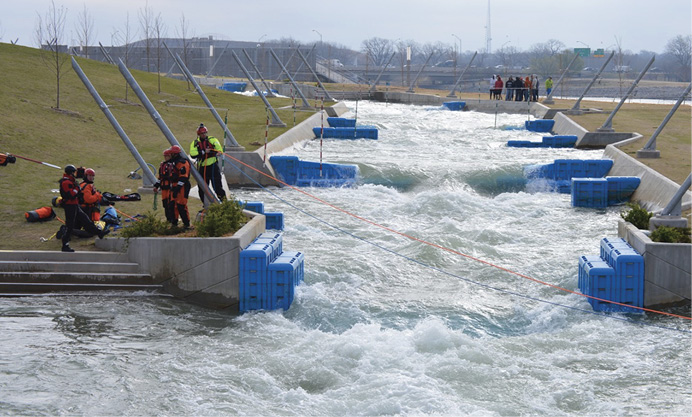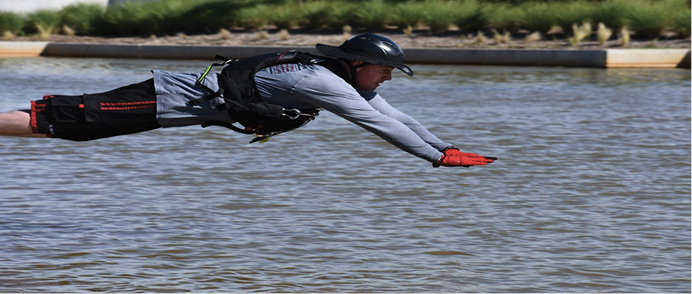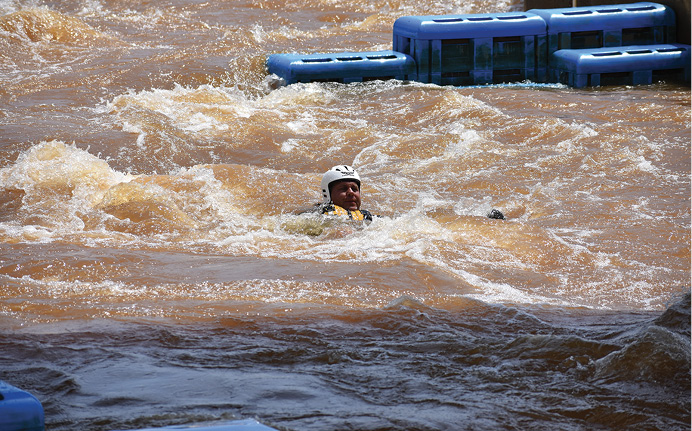
As a swiftwater instructor, I am often asked, “How do we organize a swiftwater rescue team?” This loaded question has no simple answer; it requires much more than a simple checklist. As with any technical rescue discipline, swiftwater rescue preparedness must start with the three legs of the rescue tripod: people, equipment, and training. Each leg challenges our readiness and response capabilities. Budget limitations make it hard to find enough of the right people and to train and equip them properly as competent water rescue specialists. Often, rescue equipment is such a low priority because of its cost relative to the limited incidence of technical rescues. Finally, training is the third leg needed for stability and support for a successful rescue program. In many departments, training is not a problem and is encouraged and well-funded. However, in others, training is a nice word to throw around until it comes to spending money, and then departments shy away from it.
The first step in creating a successful water rescue program is to strengthen all three legs of the tripod.

(1) In an offensive water entry, the rescue swimmer places his hands in front to break up the water and protect his face as he makes entry. It allows the swimmer to keep his head up and out of the water on contact with the water and keep his eyes on the victim. Notice also his body is flat, to minimize his impact on the water and to avoid injury when entering the water. (Photos by author.)

(2) Crew coordination is essential when executing maneuvers in a boat. The crew must work together and communicate to ensure proper boat handling. All three members leaning into the turn allows the boat to corner much more efficiently.
RELATED FIREFIGHTER TRAINING
Fundamentals of Open Water Rescue
HELICOPTER OPERATIONS IN SWIFTWATER RESCUES
SWIFTWATER RESCUE TACTICS, Part 1 | Part 2
Personnel
We must find the right people to ensure mission safety and success. They must not just fit a specific physical description, but they must also have the right mindset, desire, and motivation and be dedicated to going above and beyond the daily firefighter duties and responsibilities. Our rescue personnel are taught that their first responsibility is to be a servant to our citizens regardless of what that takes. Whether it’s an emergency medical services (EMS) call, public education, code enforcement, arson investigation, firefighting, or auto extrication, your personnel must be on top of their game and understand why first responders exist. As public servants, we take an oath to always be there for our citizens and to be ready to respond and give our best. It takes a special individual to accept this great responsibility and a high level of dedication to train and be ready for any emergency.
Your water rescue team personnel must have a passion for water rescue equal to their passion for all the other firefighter skills; they cannot compromise their duties to the citizens in any required phase of rescue or response. It’s not just a way to obtain initial training and get a nice shirt, cap, or patch and then be done with it. Members must engage in continual training just as they do for their fire, EMS, and leadership skills. In addition to their focusing on water rescue and continual training, they must still adhere to their responsibility to serve their citizens as a firefighter.
Another personnel challenge is that your department/agency may already be experiencing staffing issues. It is hard enough to staff stations day to day and perform daily firefighter operations; water rescue presents additional responsibilities. Firefighters are already going above and beyond in public education, training, code enforcement, and arson investigation. If your personnel are spread too thin already, then a standalone water rescue team may not be feasible for your department. To ensure the best service for your community and to avoid overtasking your personnel, the best choice for your department may be a county or areawide team.
Below are the staffing requirements for a basic swiftwater rescue team based on position. Twelve members are preferable. Ten is the minimum and would be adequate for a small-scale water rescue incident. The team’s size must increase as the incident needs and complexity elevate. The positions are as follows:
- 1-2 upstream spotters.
- 2-4 downstream safeties, trained to the swiftwater technician level.
- 1 team leader/incident commander/safety officer, trained to the swiftwater technician level. Although one person can take on all these roles, it is preferable to assign one person to fill each role. This depends on the response capabilities of each team.
- 4 rescuers, trained to the swiftwater technician level.
- 2 support personnel.
Equipment
Any rescue equipment catalog or Web site will overwhelm you with the vast amount of water rescue equipment and its cost. Weigh what you need, what you want, and what equipment looks great in a picture but serves little or no purpose in a rescue.
Funding is another challenge. Rescue equipment is costly and hard to justify to the chain of command when it runs the numbers compared to the number of water rescues your agency performs each year.
To counter the lack of funding argument and to support the need for equipment, use YouTube, professional media, and other news stories showing how firefighters have had to perform water rescue around the country. Also, note that the lack of proper equipment, such as thermal protection, personal flotation devices (PFDs), and the boats and motors adapted to local water and weather conditions, has resulted in firefighter injuries and deaths. Although your community may not regularly respond to significant water rescues, with research you can emphasize that your department must be prepared because your time will come. The successes and failures of other agencies can bolster your argument for the need for updated and new equipment.
What equipment does a swiftwater rescue team require? The following is not an all-inclusive list; it is the basic equipment and personal protective equipment (PPE) for a water rescue team.
Individuals
- Type V PFD.
- 2 throw bags.
- 3 aluminum locking carabiners.
- Prusik.
- 15 feet of webbing.
- Whistle.
- 2 lights (headlamp and flashlight).
- 2 glow sticks (1 any color, 1 red).
- Window punch.
- Blunt-tip knife.
- Dry suit.
- Gloves.
- Water rescue helmet.
- Swiftwater boots (preferably not dive booties).
Teams
- 600 feet of 7⁄16-inch poly rope for reeving lines.
- 2 200-foot 7⁄16-inch poly ropes for tethered systems/control lines.
- 400-foot ½-inch life safety line for highline/tensioning rope.
- 4 sets of 2 prusiks (1 large, 1 small).
- Versatile 1-inch and 2-inch webbing cache (10-, 15-, 20-, and 25-foot).
- 30 aluminum locking carabiners.
- 10 aluminum pulleys (2 double pulleys).
- 2 anchor plates.
- 10 additional throw bags.
- Victim PFDs (4 adult, 2 child, 2 infant).
- Victim helmets (2 adult and 2 child).
- Additional helmet lights flashlights.
- Portable scene lighting.
- Line across device (line gun or slingshot).
- Zip ties.
- First-aid kit.
- Inflatable rescue raft equipped with flip lines, paddles, patch kit, and heavy-duty tape.
- Motorized inflatable rescue boat equipped with
- appropriate motor size based on boat requirements and local needs.
- flip lines.
- tools, extra props, patch kit, flares, heavy duty waterproof tape, fire extinguisher, appropriate lighting for night operations, tow rope, extra motor keys with tethers, spare start cord, proper oil, extra fuel tank, paddles, and air pump.
Training
Often, initial rescue training is not the challenge; it is maintaining continual, challenging, and advanced training. The biggest challenge is not only about getting funding for training from your organization/agency; it’s finding additional challenging training for your team. Also, team members must embrace the need for training beyond initial training, which is simply an introduction to the basic skills. Continual training is vital to gaining expertise and the knowledge/skills/abilities necessary to become a subject matter expert. Swiftwater training is hard to simulate in a safe environment; we must always try to obtain safe training that is as realistic as possible to challenge ourselves and our team. As creatures of habit, we often find comfort in training within our own organization and with familiar instructors. I cannot emphasize enough the importance of seeking training in different parts of the country to experience different points of view, perspectives on training and rescue tactics and techniques, and local geographic rescue challenges.

(3) A crew is setting up a downstream safety with a tension diagonal and a rope curtain. Training and working together are paramount in this evolution because voice communication with other rescuers on the other side of the river is not possible. Hand and whistle signals are often the way to communicate. Crews on both sides of the river must work together and understand what the other team members are doing.

(4) If a rescuer accidentally falls into the water, he must maintain proper body positioning and control until he can find a way out of the water. Notice that his head is up, he’s looking for hazards and escape routes as he moves downstream, and he’s keeping his feet up to avoid foot entrapment.
Although it may seem redundant, take training classes several times. Each time I take or teach a class, I learn something new I can apply to real-world situations. Many times, with your first exposure to training, you cannot comprehend the big picture; you are focused only on the small tasks you may be instructed on at the time.
Recall your probationary firefighter days pulling your first few handlines. You practiced the technique and knew exactly how to deploy the different hoseloads your agency uses, but you never really understood more than getting the nozzle to the door. You didn’t think about deployment based on fire conditions, building construction, fire location, using a smooth bore vs. a fog nozzle, or the appropriate size line for the fire conditions. You just pulled the line to a spot your training officer designated. But once you learned to pull a handline correctly without fail, you focused on the fire conditions and location and the other elements that go along with proper hoseline and nozzle selection.
It’s the same with water rescue training. You are no longer only throwing a throw bag, setting up a tension diagonal, or learning defensive and offensive swim techniques. As you repeat these courses and continue training, you understand hydrology and where to throw a throw bag based on hydrology, the importance of learning a tension diagonal and throw bags for downstream safeties. The more you train, you can see beyond the individual skills and see how each skill fits into the overall success of a water rescue.
Don’t neglect the night training; night operations add a new element of struggle to the most basic skills we perform easily during the day. We must be prepared for rescues at any time; night operations are moving into more advanced training. Ensure your crews are competent and ready for the increased challenge before progressing. Before you advise emergency management, your chain of command, or your community that you are a water rescue team, be absolutely confident that your team has the knowledge, skills, and abilities necessary to perform the required skills. The emergency scene is not the place to learn; know your limitations prior to the rescue. If the members aren’t ready for night operations, don’t put them out there.
Training Plan
Ensure that your training has a goal whether it is based on time or your team’s ability to perform certain rescues. For example, I talk to departments about their boat rescue training, and some will say, “Yes, we do regular boat training.” But when I ask for a lesson plan, I get the blank stare. Their boat “training” is simply putting their inflatable rescue boat (IRB) in the lake or river and drive fast and make a few J-turns. An example of a boat training plan is teaching the crews maneuvers in nonmoving water that are applicable to the swiftwater environment. Progress to the more complex task of swiftwater training.
Following is a nonmoving water training plan:
- Serpentine.
- Shallow approaches to a dock or shore, in forward and reverse.
- J-turns.
- Simulated eddy catches using buoys as object causing eddy.
- Boat flips.
- Abandon boat maneuvers that simulate being thrown from a boat and recovering.
- Victim pickups; start with a PFD and progress to live victims.
- Emergency stops.
- Overloaded boat operations. Load a boat with too many rescuers and perform maneuvers to simulate the lack of controllability when the boat is overloaded with victims and rescuers.
- Pacing.
- Towing and being towed.
- Hasty searches from the boat along the shoreline.
In creating a water rescue team, you must develop a strong foundation. In pursuit of obtaining certification, you must put equal time and effort into equalizing the three rescue legs of personnel, equipment, and training. When you establish equality among these three, then your team can grow and be the asset that your community and your citizens deserve.
Greg Merrell is a major with the Oklahoma City (OK) Fire Department and a station officer and ride-out district chief officer. Previously, he served as the station/company officer with the Technical Rescue and the HazMat Response stations. Merrell is a task force leader with the US&R Task Force OK-TF 1 and has instructed rescue teams throughout the United States.

